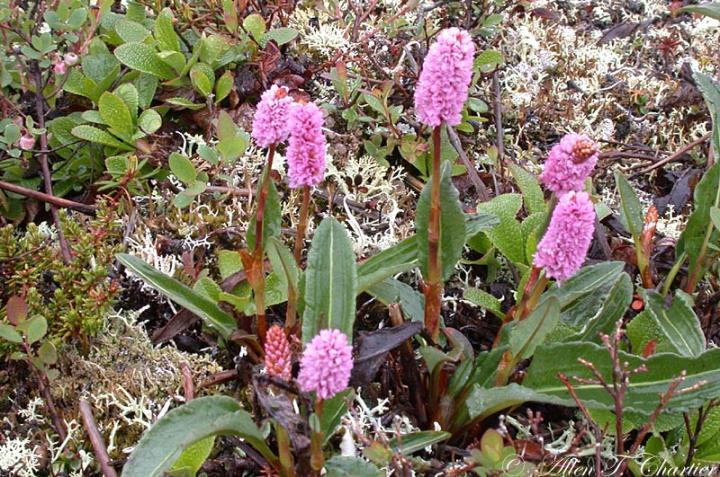Team discovers a significant role for nitrate in the Arctic landscape

Ecologists have discovered that arctic tundra plants take up much more nitrate than previously thought. Some species, such as the pink flowering plant Polygonum bistorta, take up even more nitrate than plants in low latitude, high-nitrate environments. Credit: Allen Chartier
The study, published in Proceedings of the National Academy of Sciences, found that plants in northern Alaska's tussock tundra took up nitrate at comparable rates to vegetation in nitrate-rich ecosystems. Nitrate contributed about one-third of the nitrogen the tundra plants used. Some of the species studied, such as Polygonum bistorta, a pink flowering plant, took up nitrate at even higher rates than species found in low-latitude, high-nitrate environments.
The findings are important in the context of human-caused climate change, which is expected to increase nitrogen, and potentially nitrate, levels in tundra soil. As the climate warms, the microbial processes that generate nitrate could speed up. In addition, permafrost — a layer of soil below the surface that remains frozen throughout the year — could thaw, adding additional nitrogen to the ecosystem. Some of this nitrogen could be converted to nitrate.
The tussock tundra covers a large part of northern Alaska and is currently composed of sedges, herbaceous ground cover, and woody shrubs (about a third coverage for each). The landscape's productivity is limited by nitrogen availability. If released from this limitation, woody shrub species, such as birch and willow, could become more dominant and shade out other plants as the climate warms. The discovery that nitrate is an important nitrogen source for tundra plants will need to be factored into future projections of species composition.
“As the nutrients start cycling faster and the vegetation starts growing faster, that should stimulate all the vegetation on the tundra. After a while, the woody species should be able to overtop the ones that don't have stems, that can't stand up that high.
So you tend to lose the sedges and the mosses and the lichens,” explained study co-author Ed Rastetter, a senior scientist at the MBL Ecosystems Center and principal investigator for the National Science Foundation's Arctic Long-Term Ecological Research site at Toolik Lake, Alaska, where part of the research was conducted.
Because nitrogen and carbon cycles are tightly coupled, the team's discovery might also alter projections of carbon storage or release from arctic ecosystems as the climate warms. The world's permafrost is packed with the remnants of plants and animals accumulated over thousands of years, and it contains twice as much carbon as is currently in the atmosphere.
Rastetter stresses that more research is needed to confirm the study's findings and to better understand the importance of nitrate relative to other forms of nitrogen in arctic tundra ecosystems.
###
MBL Ecosystems Center scientists Gaius Shaver, Anne Giblin, James Laundre and Rastetter contributed to the study. They collaborated with researchers from China, Japan, Norway and the United States.
Citation:
Xue-Yan Liu et al (2018) Nitrate is an important nitrogen source for Arctic tundra plants. Proc. Natl. Acad. Sci. doi: 10.1073/pnas.1715382115
The Marine Biological Laboratory (MBL) is dedicated to scientific discovery – exploring fundamental biology, understanding marine biodiversity and the environment, and informing the human condition through research and education. Founded in Woods Hole, Massachusetts in 1888, the MBL is a private, nonprofit institution and an affiliate of the University of Chicago.
Media Contact
All latest news from the category: Earth Sciences
Earth Sciences (also referred to as Geosciences), which deals with basic issues surrounding our planet, plays a vital role in the area of energy and raw materials supply.
Earth Sciences comprises subjects such as geology, geography, geological informatics, paleontology, mineralogy, petrography, crystallography, geophysics, geodesy, glaciology, cartography, photogrammetry, meteorology and seismology, early-warning systems, earthquake research and polar research.
Newest articles

Superradiant atoms could push the boundaries of how precisely time can be measured
Superradiant atoms can help us measure time more precisely than ever. In a new study, researchers from the University of Copenhagen present a new method for measuring the time interval,…

Ion thermoelectric conversion devices for near room temperature
The electrode sheet of the thermoelectric device consists of ionic hydrogel, which is sandwiched between the electrodes to form, and the Prussian blue on the electrode undergoes a redox reaction…

Zap Energy achieves 37-million-degree temperatures in a compact device
New publication reports record electron temperatures for a small-scale, sheared-flow-stabilized Z-pinch fusion device. In the nine decades since humans first produced fusion reactions, only a few fusion technologies have demonstrated…





















